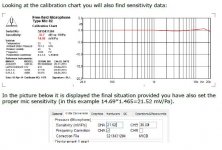Hi. Well I can generate my own 65k sweep file and play it on any digital device. Hope that would work. Should in theory, when played timewise closely to my trigger in the ClioPkt.
I mean, its expecting some input within certain timeframe and evaluates it
That for the external DA.
With the AD i could feed from ClPkt and record the input digital into a Wave, then deconvolve it... with some other applications. Ill give it a try one day.
Another topic: how powerful is the output for measuring drivers sensitivity??
I think the USB bus only provides 5V/0.5A. Dont know what Clio does out of it, but it cant be hell lot of power Esp considering 150Ohm output impedance...
Esp considering 150Ohm output impedance...
But. I can select 2.83 Volt on the output. Which should drive an 8 Ohm driver with aprox 1 Watt and should then catch the (for example my 8" fullrange in the higher octaves) 95-100dB in a Meter distance.
Well, this simple-minded theory doesnt work out here:

This was even only half a meter, 3.4 Volt, still faaaar away
I entered the calibration sensitivity from the attached certificate, 17.5mv/Pa (for 114???)
Wheres my mistake?
And can someone further explain those settings in detail?
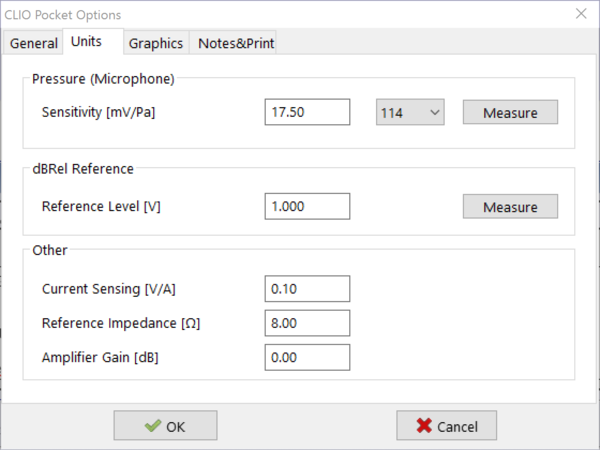
I mean, its expecting some input within certain timeframe and evaluates it
That for the external DA.
With the AD i could feed from ClPkt and record the input digital into a Wave, then deconvolve it... with some other applications. Ill give it a try one day.
Another topic: how powerful is the output for measuring drivers sensitivity??
I think the USB bus only provides 5V/0.5A. Dont know what Clio does out of it, but it cant be hell lot of power
But. I can select 2.83 Volt on the output. Which should drive an 8 Ohm driver with aprox 1 Watt and should then catch the (for example my 8" fullrange in the higher octaves) 95-100dB in a Meter distance.
Well, this simple-minded theory doesnt work out here:

This was even only half a meter, 3.4 Volt, still faaaar away
I entered the calibration sensitivity from the attached certificate, 17.5mv/Pa (for 114???)
Wheres my mistake?
And can someone further explain those settings in detail?

Manual rambles about something else
UP
Can the thread name be changed to cover all CLIO models?
UP
Attachments
Last edited:
well that 20 volt seems to be mic-supply from old devices. Current Clio manual for v12 sais it operates with 8.2 volt as well. That means on the new devices that mvPA goes straight 1:1 i assume.
But the 94/114 is only for the meter-calibration? I thought it might be 17.5mV for 94 OR 114dB ... in that case depending on the setting evaluating input signal 20dB different??
Anyhow. Seems like i should try with an amp again...
But the 94/114 is only for the meter-calibration? I thought it might be 17.5mV for 94 OR 114dB ... in that case depending on the setting evaluating input signal 20dB different??
Anyhow. Seems like i should try with an amp again...
But the 94/114 is only for the meter-calibration? I thought it might be 17.5mV for 94 OR 114dB
Yes, selection only for calibration
Sensitivity in mV/PA -> 94 (93.979400087) dB SPL = 1 PA (Sound pressure)
means 17.5 mV at 1 PA -> 94 dB SPL
OK. Amp is plugged. Wow. Now i know how much 100dB hurts 
The slight difference is definitely noticeable...
But. Im not getting any happier here. I precisely measured the Amp though.
I set the atenuator in a position where 2.83v in got 2.83v out, acc. to clio pocket looped through the amp.
Then i plugged a 8.2R 5% resistor on the amp/parallel to clio and had to feed 2.788 in to get 2.83 out.
Then i plugged the 8" driver and had to use 2.790 In to get 2.83 out.
Is that normal so far? Guess depends on driver & amp damping??
Anyhow, serious magazine measured that driver:
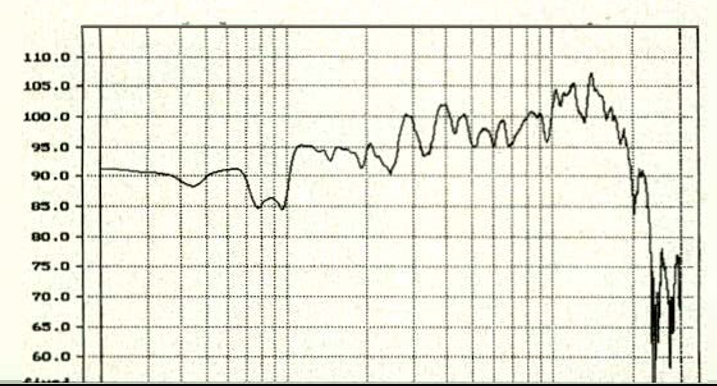
And I got that with 2.83V:
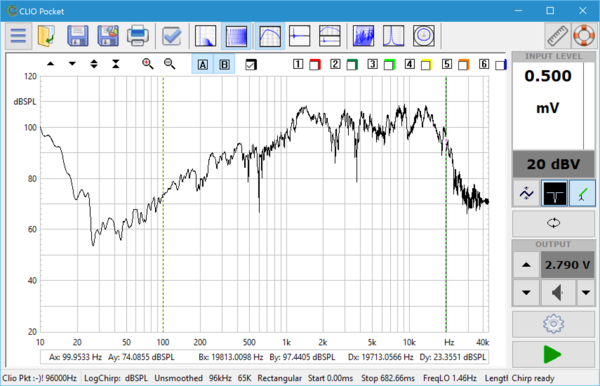
I know, my driver wasnt in an infinite baffle under anch. chamb. conditions.
But it was placed on bench, surrounded by form, no baffle.
With 8" i'd expect a significant drop below 1-2k, with the typical OB peak then, but at least 5-20k the highs should be aprox like on the magazine.
Well the efficiency is 3-5dB too high.
Same as Qts 0.35 instead of 0.21
It all works somehow but the results seem to be not soooo accurate

The slight difference is definitely noticeable...
But. Im not getting any happier here. I precisely measured the Amp though.
I set the atenuator in a position where 2.83v in got 2.83v out, acc. to clio pocket looped through the amp.
Then i plugged a 8.2R 5% resistor on the amp/parallel to clio and had to feed 2.788 in to get 2.83 out.
Then i plugged the 8" driver and had to use 2.790 In to get 2.83 out.
Is that normal so far? Guess depends on driver & amp damping??
Anyhow, serious magazine measured that driver:

And I got that with 2.83V:

I know, my driver wasnt in an infinite baffle under anch. chamb. conditions.
But it was placed on bench, surrounded by form, no baffle.
With 8" i'd expect a significant drop below 1-2k, with the typical OB peak then, but at least 5-20k the highs should be aprox like on the magazine.
Well the efficiency is 3-5dB too high.
Same as Qts 0.35 instead of 0.21
It all works somehow but the results seem to be not soooo accurate
aaand the next odd thing:

Step response shows significant low-freq. noise.
OK the magnitude too.
I wonder if the mic is ok ... I dont have any noise here, its dead silent.
Langston, help me pls
Feel bit like an idiot here. Still hope its me not the device.
With REW, Arta, Acourate and the other equipment i always got reasonable results.

Step response shows significant low-freq. noise.
OK the magnitude too.
I wonder if the mic is ok ... I dont have any noise here, its dead silent.
Langston, help me pls
Feel bit like an idiot here. Still hope its me not the device.
With REW, Arta, Acourate and the other equipment i always got reasonable results.
Last edited:
You guys better be having fun while you mess around with all this stuff - that's the goal! 
Thoughts
1. I got up around 5am this morning to go to the bathroom and made a huge mistake - I checked my email!
2. On the calibration figure that comes with the MIC-02 included with CLIO Pocket, make sure you select 94dB in the options dialog box when you enter the mV/Pa sensitivity number. This sensitivity metric describes the voltage output from the microphone in millivolts as a result of a given amount of pressure applied to the microphone diaphragm in units called Pascals. 1 Pascal or Pa is equivalent to 94dB SPL.
The threshold of hearing (for a little girl around 3.5kHz) is generally 0dB SPL or 0.000020Pa or 20µPa. The loudest sound we can tolerate briefly is generally 120dB SPL or about 20Pa. 20Pa/20µPa = 1,000,000. An stunning chemo-electro-acoustic design.
3. CLIO Pocket supplies a phantom voltage of about 8V DC. The CLIO 12 interface supplies about 24V DC. As stated in the calibration data included with Audiomatica's mics, the mV/Pa figure correlates with the 8V supply voltage. If you use these mics with CLIO 12, for example, you'll need to recalibrate the mic for the higher supply voltage. It will increase sensitivity by about 1.5dB, which also allows the mic to handle a bit higher SPL prior to distortion with no increase in noise floor.
4. On driving loudspeakers directly from CLIO Pocket, I'm amazed you got such good results. Ohm's law tells us that at the approx. 3V maximum output through the internal 150Ω resistor driving a dead short will dissipate 0.06W or 60mW in power. You can do this all day without damaging the CLIO Pocket interface. Driving an 8Ω resistive load would dissipate only 0.003W or 3mW in power across the DUT. That's fine in the electrical domain, but you'll need an amplifier to achieve a reasonable S/N ration in the acoustic domain.
Ohm's law tells us that at the approx. 3V maximum output through the internal 150Ω resistor driving a dead short will dissipate 0.06W or 60mW in power. You can do this all day without damaging the CLIO Pocket interface. Driving an 8Ω resistive load would dissipate only 0.003W or 3mW in power across the DUT. That's fine in the electrical domain, but you'll need an amplifier to achieve a reasonable S/N ration in the acoustic domain. 
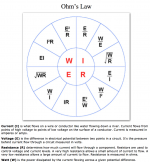
Thoughts
1. I got up around 5am this morning to go to the bathroom and made a huge mistake - I checked my email!
2. On the calibration figure that comes with the MIC-02 included with CLIO Pocket, make sure you select 94dB in the options dialog box when you enter the mV/Pa sensitivity number. This sensitivity metric describes the voltage output from the microphone in millivolts as a result of a given amount of pressure applied to the microphone diaphragm in units called Pascals. 1 Pascal or Pa is equivalent to 94dB SPL.
The threshold of hearing (for a little girl around 3.5kHz) is generally 0dB SPL or 0.000020Pa or 20µPa. The loudest sound we can tolerate briefly is generally 120dB SPL or about 20Pa. 20Pa/20µPa = 1,000,000. An stunning chemo-electro-acoustic design.
3. CLIO Pocket supplies a phantom voltage of about 8V DC. The CLIO 12 interface supplies about 24V DC. As stated in the calibration data included with Audiomatica's mics, the mV/Pa figure correlates with the 8V supply voltage. If you use these mics with CLIO 12, for example, you'll need to recalibrate the mic for the higher supply voltage. It will increase sensitivity by about 1.5dB, which also allows the mic to handle a bit higher SPL prior to distortion with no increase in noise floor.
4. On driving loudspeakers directly from CLIO Pocket, I'm amazed you got such good results.

Hi Josh:
You are no idiot - you are simply at the most fun part of the learning curve with this stuff. There is nothing wrong with your analyzer, it's just the measurement setup.
You have two options, (a) take the blue pill and just hack away at it for years and never experience the thrill that comes from truly successful designs, or (b) take the red pill and see how far the rabbit hole goes.
Hide the women and children and whatever you do, do NOT click on The Red Pill.
You are no idiot - you are simply at the most fun part of the learning curve with this stuff. There is nothing wrong with your analyzer, it's just the measurement setup.
You have two options, (a) take the blue pill and just hack away at it for years and never experience the thrill that comes from truly successful designs, or (b) take the red pill and see how far the rabbit hole goes.
Hide the women and children and whatever you do, do NOT click on The Red Pill.
Hi Langston.
Well theres 3kg Alnico on the tweeter, so it didnt need a lot to work
I switched to 94 and got the same result. Back n forth, no difference in SPL reading.
As my last measure with a real power amp was rather 5dB too much, i think i dont miss any 20dB anymore, so im rather left with uncertainty how to cal the voltage from the amp to catch the real spl.
I thought measuring 2.83 volts with a 1k sine on either speaker or dummy-resistor should work. But 5dB are still too much tolerance.
Is it normal to be 5dB off? I wouldnt complain bout 1, even 2... but this.
No noise, reflection, few cm mic offset can explain 5dB...
Well theres 3kg Alnico on the tweeter, so it didnt need a lot to work
I switched to 94 and got the same result. Back n forth, no difference in SPL reading.
As my last measure with a real power amp was rather 5dB too much, i think i dont miss any 20dB anymore, so im rather left with uncertainty how to cal the voltage from the amp to catch the real spl.
I thought measuring 2.83 volts with a 1k sine on either speaker or dummy-resistor should work. But 5dB are still too much tolerance.
Is it normal to be 5dB off? I wouldnt complain bout 1, even 2... but this.
No noise, reflection, few cm mic offset can explain 5dB...
2. On the calibration figure that comes with the MIC-02 included with CLIO Pocket, make sure you select 94dB in the options dialog box when you enter the mV/Pa sensitivity number.
sorry Langston , thats wrong.
It makes no difference if you the senstivity number at 94 or 114, the selection is only for measure the Mic sensitivity with an calibrator.
The Mic sensitivity will be entered in mV/Pa
Regards Dirk
Actually he is correct.
You cannot measure a mic sensitivity with a calibrator (you can, but this is not the scope here). You just check your microphone against a calibrated device to see if you are within spec or not.
Most microphone are calibrated at 94dB. Not sure the THD levels for the at 114dB for Clio mics
You cannot measure a mic sensitivity with a calibrator (you can, but this is not the scope here). You just check your microphone against a calibrated device to see if you are within spec or not.
Most microphone are calibrated at 94dB. Not sure the THD levels for the at 114dB for Clio mics
Last edited:
...Also a note from my side, it seems that Audiomatica has now increase the price with release of "Clio 12 - USB Hardware".
In Europe it's now ~ 500 € more expensive than "Clio 11 - FW Hardware"
Hi Dirk:
Audiomatica doesn't force its distributors to sell at a given price, but they do of course provide a suggested end-user pricing sheet to us. I was shown a crazy high price from one country recently, but that country also taxes imports at 100% which doubles the cost of the stuff to the distributor.
Another observation is that the first CLIO system (v10 had just been released) I bought from the then US distributor was $2,400 plus shipping. That was almost a decade ago and I sell CLIO 12 for $2,295 now. I think the other guy didn't do his homework on minimizing currency transfer, exchange rate and shipping fees like I do.
The suggested end-user price for CLIO 12 Standard is €1.950, which is about an 8% increase from CLIO 11 Standard. But as in that prior example, many countries tax the import of goods to the distributor making it tough for them to sell at suggested targets.
The upgrade cost from CLIO 10 or 11 Standard to 12 Standard including both software and hardware is €290. They also test the hardware and update electrolytics, etc., as needed to get it preforming to new specifications. A great deal IMO.
Last edited:
Not sure the THD levels for the at 114dB for Clio mics
A QUESTION?
All (4) CLIO mics use the same capsule, they are just different sizes and shapes for different applications.
Spec sheet stating 130dB SPL maximum
A customer recently returned the longer 10" version to me stating it was defective. He was wrong, but I sent him another one anyway. Part of the biz. Using the 24V CLIO 12 system my measurements of the returned microphone showed that it can handle significantly higher levels than 130dB. It also matched the frequency response of the spec sheet very closely.
Low Frequency
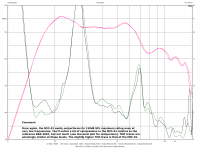
High Frequency
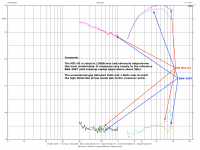
Hi Langston,
thanks for explanation of the Audiomatica price politic.
But the end user prespectiv in Germany is a little bit different.
Few month ago the local distribut sells Clio 11 for EUR 1.799 (incl. tax),
the actual price is EUR 2.295. That's more than 25 % ....
Regards Dirk
thanks for explanation of the Audiomatica price politic.
But the end user prespectiv in Germany is a little bit different.
Few month ago the local distribut sells Clio 11 for EUR 1.799 (incl. tax),
the actual price is EUR 2.295. That's more than 25 % ....
Regards Dirk
I see nothing wrong with the price policy. Maybe it was a kept low to introduce the new series, as it happens with every other manufacturer. Phone prices drop when the new model launches, etc
Price for Upgrade is OK, considering the switch from 10 QC to 11QC just for the software was 290 Eur
Bloody hell, not sure what I was trying to say here.
Price for Upgrade is OK, considering the switch from 10 QC to 11QC just for the software was 290 Eur
You cannot measure a mic sensitivity with a calibrator (you can, but this is not the scope here). You just check your microphone against a calibrated device to see if you are within spec or not.
Most microphone are calibrated at 94dB. Not sure the THD levels for the at 114dB for Clio mics
Bloody hell, not sure what I was trying to say here.
Actually he is correct.
I think not
Here 2 measurements, 1st Mic Senitivity set with 94, 2nd with 114 :
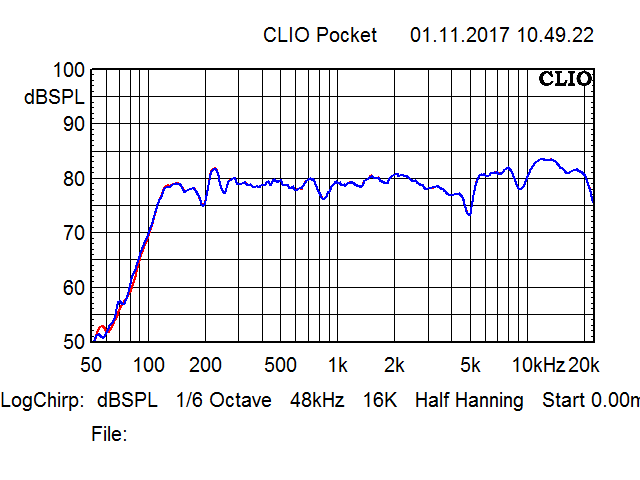
You cannot measure a mic sensitivity with a calibrator (you can, but this is not the scope here). You just check your microphone against a calibrated device to see if you are within spec or not.
Most microphone are calibrated at 94dB. Not sure the THD levels for the at 114dB for Clio mics
Don't understand what you mean ...
Of course you can measure the Mic sensitivity with an SPL calibrator, like this :
Galaxy Audio CM-C200
Regards Dirk
Don't understand what you mean ...
Regards Dirk
Me neither.
As for the calibrator, there are some good companies in the EU/UK with products made here.
I am using the Cirrus Research CR514 with 264A SPL meter. Great tools, a bit upset by the cost of calibration at the factory which is over 400Eur
Last edited:
- Home
- Design & Build
- Equipment & Tools
- CLIO Pocket

